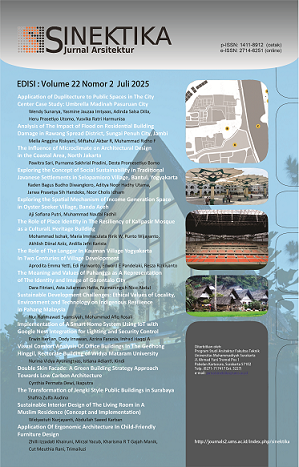The Role of Langgar in Kampung Kauman Yogyakarta in Two Centuries of Village Development
DOI:
https://doi.org/10.23917/sinektika.v22i2.8417Keywords:
Kampung, Kauman, Langgar, Settlement, YogyakartaAbstract
This article analyzes the role of langgar in Kampung Kauman Yogyakarta during the period of village development from 1773 to 1930. The three periods are when Kampung Kauman Yogyakarta first appeared, the second is during the batik industry period, and the third is during the birth of community organizations in Kampung Kauman Yogyakarta, namely Muhammadiyah and Aisyiyah. Langgar is a space for religious and social activities in Muslim-populated villages in Java, Indonesia. This study aims to explain the role of the seven langgars that still exist today in the socio-cultural life of Kampung Kauman Yogyakarta, related to local values, public space, and social roles. This research uses a qualitative method with the Grounded Theory method. This research explains that langgar in Kampung Kauman Yogyakarta is not only present as a place of worship but also as a role of a node for the development of village settlements and community social spaces. The output of this article is expected to be the basis for a research framework that needs to be developed to study the role of the langgar and the sustainability of settlements in Kampung Kauman Yogyakarta.
Downloads
References
Aazam, Ziad. (2005). The Social Logic of The Mosque: A Building and Urban Spatial Investigation. The 5th International Space Syntax Symposium, ISBN 90-8594-002-8
Abdelalim, Marwa F. (2022). Impact of Urban Compactness, Architectural Form and Climatic Consederations : an Analysis in Traditional Islamic Buildings. IOP Conf. Series: Earth and Environmental Science. Doi: 10.1088/1755-1315/1056/1/012010
Budiman, Hanif. (2019). Instanbul, The Development of Islamic City Thinking. MATEC Web of Conferences 280. Doi: https://doi.org/10.1051/matecconf/201928002005
Creswell, J. W. (2014). Research Design: Qualitative, Quantitative and Mixed Methods Approaches (4th ed.). Thousand Oaks, CA: Sage
Darban, A. A. (2010). Sejarah Kauman : Menguak Identitas Kampung Muhammadiyah, Suara Muhammadiyah : Yogyakarta
Depari, C. D. A. (2017). Transformasi Ruang Kampung Kauman Yogyakarta Sebagai Produk Sinkretisme Budaya. Jurnal Arsitektur KOMPOSISI, 10(1), 11. Doi: Https://Doi.Org/10.24002/Jars.V10i1.1044
Dovey, Kim. (2008). Framing Places: Mediating Power in Built Form. London: Routledge.
Glaser, B., and Strauss, A. (1967). The Discovery of Grounded Theory: Strategies for Qualitative Research. Mill Valley, CA: Sociology Press.
Heng, J. and Kusuma, A. B. (2013). Konsepsi Langgar Sebagai Ruang Sakral Pada Tanean Lanjang. Jurnal Arsitektur KOMPOSISI, 10(4), 217. Doi: https://doi.org/10.24002/jars.v10i4.1167
Ismail, F. And Pranggono, B. (2022). Kajian Kampung Islam Kauman Di Kecamatan Gondomanan Kota Yogyakarta. Bandung Conference Series Urban & Regional Planning, 2(2), 543-549. Doi: Https://Doi.Org/10.29313/Bcsurp.V2i2.3624
Kosim, Mohammad. (2009). Langgar sebagai Institusi Pendidikan Keagamaan Islam. Tadris 4(2), 236-250.
Lefebvre, H. (1974). The Production of Space. Blackwell Publishing.
Mawardi, Kholid. (2014). Langgar: Institusi Kultural Muslim Pedesaan Jawa. Jurnal Kebudayaan Islam, 12(1), 50-61. Doi: https://doi.org/10.24090/ibda.v12i1.435
Munt, Harry. (2014). The Holy City of Medina, Sacred Space in Early Islamic Arabia. Cambridge University Press. Doi: https://doi.org/10.1017/CBO9781107323773
Pancer, S. Mark. (2015). The Psychology of Citizenship and Civic Engagement : The Influence of Places of Work and Worship on Civic Engagement, 57-73. Oxford University Press : New York
Rabbaniyah, H. I and Ikaputra. (2024). Kategorisasi Langgar Berdasarkan Pola Perkembangan Spasial (Studi Kasus: Kauman Yogyakarta). MINTAKAT: Jurnal Arsitektur, 25(1), 37-48. Doi: 10.26905/jam.v25i1.10245
Rapoport, A. (1977). Human Aspects of Urban Form: Towards a Man-Environment Approach to Urban Form and Design. Oxford: Pergamon Press
Saputra, I.T, Putu Ayu P.A, and Bryan Putra P.S. (2024). Finding Genius Loci of Kauman Yogyakarta. Journal of Architectural Design and Urbanism, 6(2), 115-123). Doi: 10.14710/jadu.v6i2.21773
Setiawati, Nur Aini. (2018). Manajemen Sejarah Berbasis Komunitas: Pengembangan Kawasan Kauman Sebagai Living Museum. Bakti Budaya, 1(1), 101. Doi: Https://Doi.Org/10.22146/Bb.37934
Sholihah, A. B., Ressang, A. M., & Setiawan, W. (2024). The Architecture Of Langgar Dhuwur In Java: Vernacular Forms In Religious Architecture. Journal of Islamic Architecture, 8(1), 106-116. Doi: https://doi.org/10.18860/jia.v8i1.21107
Wijayanti, S.R, Andi M, and Syamsul Bahri. (2024). Transformasi Fungsi Masjid sebagai Sarana Ibadah dan Rekreasi dalam Perkembangan Perkotaan (Studi Kasus: Masjid 99 Kubah di Makassar). Urban and Regional Studies Journal, 6(2), 181-188. Doi: 10.35965/ursj.v6i2.4497
Yuristiadhi, Ghifari. (2020). Evolusionisme dalam Adaptasi Sosial Masyarakat Ngindungan di Kampung Kauman Yogyakarta, 1990-an - 1970-an. Jurnal Widya Citra, 1(2), 1-17.
Downloads
Submitted
Accepted
Published
Issue
Section
License
Copyright (c) 2025 Sinektika: Jurnal Arsitektur

This work is licensed under a Creative Commons Attribution-NonCommercial 4.0 International License.











